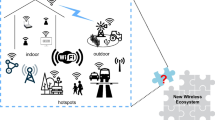Abstract
The growth in mobile communication will accelerate over the next years. Today most of the mobile subscribers use cellular services only. But this will change in the near future towards broadband wireless access services like WiFi and WiMAX. This paper describes a fundamental overview of the broadband wireless access technologies and outlines the market view, major trends and introduces OFDM technologies. New developments for integration of broadband wireless access into the operators' infrastructure are also discussed.
Similar content being viewed by others
Abbreviations
- 3G...:
-
3rd Generation (mobile networks)
- AAA:
-
Authentication, Authorization, Accounting
- AP:
-
Access point. An AP operates within a specific frequency spectrum and uses an 802.11 standard specified modulation technique. It informs the wireless clients to the wireless network and coordinates the wireless clients' use of wired resources.
- BB:
-
Broad Band
- BWA:
-
Broadband Wireless Access
- BWS:
-
Broadband Wireless Solutions
- CAP:
-
Competitive Access Provider
- CCS7:
-
Common Channel Signaling Number 7
- CPE:
-
Customer Premises Equipment
- DFS:
-
Dynamic Frequency Selection
- DSL:
-
Digital subscriber line
- DSSS:
-
Direct Sequence Spread Spectrum
- FDD:
-
Frequency Division Duplexing
- FITL:
-
Fiber in the Loop
- FNO:
-
Fixed Network Operator
- GSM:
-
Global System for Mobile Telecommunications; European standard for 2nd generation mobile cellular telecommunication systems
- HLR:
-
Home Location Register; node where subscriber-specific data is permanently stored in GSM systems
- HSPDA:
-
High Speed Downlink Packet Access
- IAPP:
-
Inter Access Point Protocol
- IEEE:
-
Institute of Electrical and Electronic Engineers
- IP:
-
Internet Protocol
- ISM:
-
Industrial, Scientific, Medical; a worldwide available licence-free frequency band around 2.4 GHz
- ISP:
-
Internet Service Provider
- IT:
-
Information Technology
- LAN:
-
Local Area Network
- MAC:
-
Medium Access Control
- MAC address:
-
Media access control address. This address is a computer’s unique hardware number
- MIMO:
-
Multiple Input, multiple Output
- MNO:
-
Mobile Network Operator
- MSIDM:
-
Mobile Subscriber ISDN Number
- OFDM:
-
Orthogonal Frequency Division Multiplexing
- OFDMA:
-
Orthogonal frequency division-multiple access
- PSK:
-
Phase Shift Keying
- QAM:
-
Quadrature Amplitude Modulation
- QoS:
-
Quality of service
- RF:
-
Radio frequency
- SIM:
-
Subscriber Identification Module; a key security element in GSM networks
- TDD:
-
Time Division Duplexing
- TPC:
-
Transmit Power Control
- UMTS:
-
Universal Mobile Telecommunications System; World standard for 3rd generation mobile cellular telecommunications systems
- URL:
-
Uniform Resource Locater; an address of a resource available in the internet
- VoIP:
-
Voice over Internet Protocol
- WEP:
-
Wire Equivalent Privacy; a term used when a radio link is considered as secure as a wired link
- WiBro:
-
Wireless Broadband, is the South Korean version of WiMAX
- WiFi:
-
Wireless fidelity. Used generically when referring to any type of 802.11 network, whether 802.11b, 802.11a, dual-band, and so on.
- WiMAX:
-
Worldwide Interoperability for Microwave Access
- WISP:
-
Wireless Internet Service Provider
- WLAN:
-
Wireless LAN
References
1 Cisco Systems EMEA: “Anytime Connectivity—Driving the Pentration of 802.11.b in the Public Access Market”, Feb. 2002.
2 Analysis: “The Dynamics of Availability and Demand in Public WLAN Access”, Feb. 2002.
3 Konhäuser, Walter: “Access Network Evolution Beyond Third Generation Mobile Communications”, IEEE Journal 2000, Mitautor: W. Mohr.
4 OFDM for Mobile Data Communications, Whitepaper Flarion Technologies, March 2003.
5 Understanding WiFi and WiMAX as Access Solutions, White Paper Article 2004.
Author information
Authors and Affiliations
Corresponding author
Rights and permissions
About this article
Cite this article
Konhäuser, W. Broadband Wireless Access Solutions - Progressive Challenges and Potential Valueof Next Generation Mobile Networks. Wireless Pers Commun 37, 243–259 (2006). https://doi.org/10.1007/s11277-006-9076-z
Received:
Accepted:
Published:
Issue Date:
DOI: https://doi.org/10.1007/s11277-006-9076-z
Keywords
- broadband wireless access (BWA)
- broadband wireless solutions (BWS)
- next generation mobile networks
- orthogonal frequency division multiplexing (OFDM)
- orthogonal frequency division-multiple access (OFDMA)
- wireless broadband (WiBro)
- wireless fidelity (WiFi)
- worldwide interoperability for microwave access (WiMAX)
- wireless LAN (WLAN)




